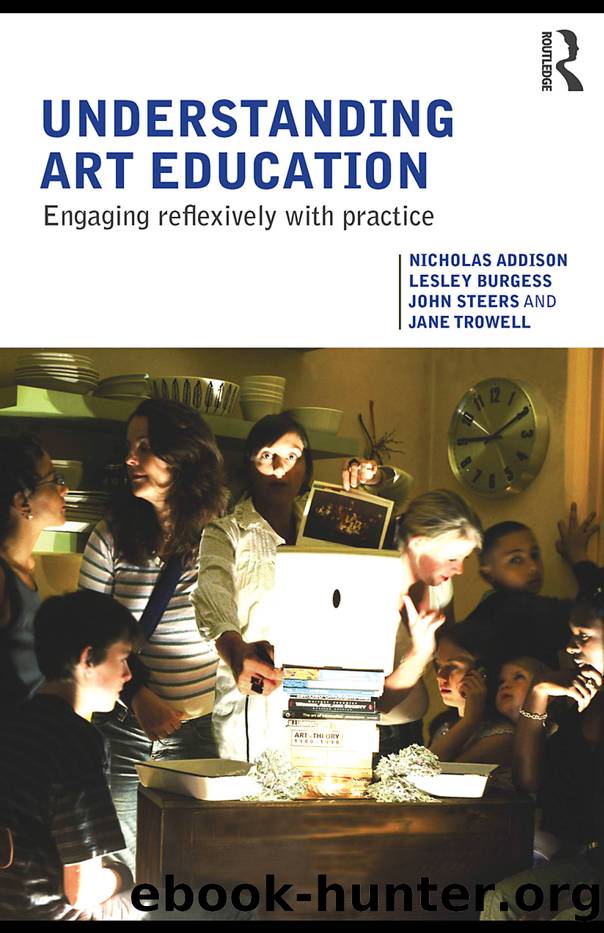Understanding Art Education by unknow

Author:unknow
Language: eng
Format: epub
Publisher: Taylor & Francis Group
Published: 2010-08-15T00:00:00+00:00
By arranging 100 open cubes in a symmetrical configuration (ostensibly as a Minimalist sculpture), Araeen establishes a simple metaphor for mutual relations. However, the way in which he invites the audience to intervene within the work questions the seeming fixity of this metaphor by potentially altering the relations through asymmetrical reconfigurations. Araeen argues that symmetrical systems can be recognised as an equalising force both socially and economically, whereas asymmetrical systems indicate hierarchies. However, despite the seeming benevolence of symmetry within this equation, it can also oblige individuals to forfeit individuality: âeveryone becomes the same with the same appearance, same haircuts, same housing, etc and is expected to express the same thingâ (Araeen 2005: in discussion with artist/teachers). This results in an unnecessary gap (or false binary opposition) between symmetry and asymmetry that ignores the dialectical relationships between the two. Deconstructions: Zero to Infinity attempts to bridge this gap: the basic symmetrical structure (equality) is maintained, it is the starting point for each day of its presentation, but it is allowed to manifest itself asymmetrically when transformed by groups and individuals in different social contexts.
After the event, artist/teachers were asked to consider how their experience as interlocutors had informed their work in education and how they might integrate the issues informing Araeenâs work into 14â19 teaching. Initially, they claimed that the issues informing Araeenâs work were out of line with their own practice. In their estimation, he was âof an earlier generationâ and, although they recognised how his work could usefully form part of an art history lesson or be integrated into a project on modernist building structures, most thought his political stance made it difficult to see how it could be included in their teaching.
Itâs of another generation, not our concerns and there is a this a gap in understanding, I canât see what itâs is trying to communicate thatâs relevant today.
It still remains for me an historical re-enactment, I canât see links with contemporary practice ⦠there are lots of artists/curators working in this way in London at the moment ⦠thereâs a lot of interest in public collaboration so it makes comparison possible ⦠but Rasheed doesnât fit in with any of these really.
I donât know ⦠we certainly positioned it within an art history perhaps thatâs the easy solution.
Download
This site does not store any files on its server. We only index and link to content provided by other sites. Please contact the content providers to delete copyright contents if any and email us, we'll remove relevant links or contents immediately.
I'm the Teacher, You're the Student by Allitt Patrick;(194)
Competing on Culture by VanWagoner Randall;Sydow Debbie L.;Alfred Richard L.;(173)
Teaching Skills For Dummies by Sue Cowley(165)
The Art & Science of Web Design by Jeffery Veen(153)
Maker-Centered Learning by unknow(139)
People Skills by Thompson Neil(130)
Lorange P. Learning and Teaching Business...Lessons...2022 by Unknown(123)
Managing Unstoppable Learning by Hierck Tom;(121)
Motivating Defiant and Disruptive Students to Learn by Rich Korb(116)
The InterActive Classroom by Nash Ron;(110)
Connecting Through Leadership by Kullar Jasmine K.;(109)
Forces of Influence by Ende Fred;Everette Meghan;(109)
Academic Advising and the First College Year by Jenny R. Fox; Holly E. Martin(105)
What We Say and How We Say It Matter by Mike Anderson(104)
Employee of the Month by Tracey Rogers(103)
Summarization in Any Subject by Wormeli Rick;Stafford Dedra;(103)
Teacher Mentoring and Induction by Portner Hal;(103)
Teaching Behavior by Terrance M. Scott(101)
Leveraging Data for Student Success : Improving Education Through Data-Driven Decisions by Laura G. Knapp; Elizabeth Glennie; Karen J. Charles(96)
